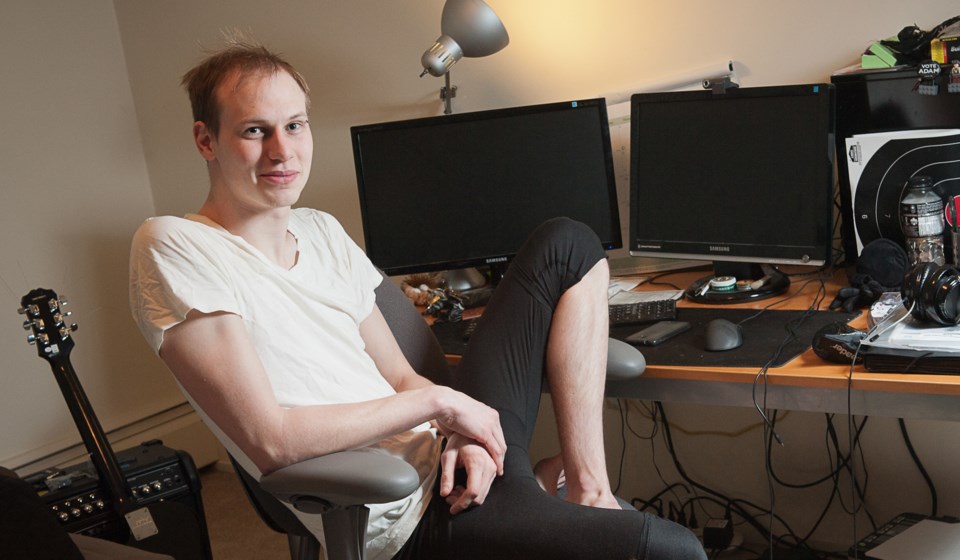Three years ago, Andrew Macdonald was so addicted to online gaming he was spending 64 of every 72 hours in front of a screen. The other eight hours, he explains ruefully, were spent collapsed on his keyboard.
It might be hard for some to comprehend days of sleep deprivation, take-out food, and insular activity, but for the 25-year-old Vancouver resident, being online offered relief from the real world.
“I hadn’t gone to college, I didn’t have too many friends, and didn’t find myself all that encouraging of a person,” he explains. “I didn’t feel like I had anything in real life that made me want to spend time in it, so I decided my digital life was more important and better. It was a place where I was recognized for skills and talents I had taught myself.”
Ever since the term “Internet addiction” was coined in 1995, however, debate over problematic Internet use has raged on. Is spending too much time online a widespread and harmful disorder, experts ask, or simply a bad habit among a predisposed few? Is it a unique condition, or the symptom of another underlying mental illness? While psychologists and psychiatrists discuss these ideas in scholarly journals, Internet addiction has become something that you, your child, or even your parents are struggling with.
The most recent survey from Insights West found that one in five smartphone users in BC described themselves as “addicted” to their device, with more than half (56 per cent) reporting that they check their device at least once an hour. And broader studies show as many as one in 10 users of digital media will develop an addiction.
It wasn’t until he lost his job and a relationship in rapid succession that Macdonald realized he needed to make a lifestyle change.
“I realized that everything around me was passing me by and I had done nothing to become a part or have a story in it. And that’s when I went, ‘Fuck it,’ I’m getting a life.”
To do so, he sought the help of Benjamin Wong, a counsellor with Richmond Addiction Services – one of the few publicly-funded agencies in BC that deal with this kind of addiction.
For therapists like Wong, Internet addiction is very real.

“Within the addictions community, it’s not even controversial anymore,” he explains.
Wong says his clinic sees 20 to 30 new families every year struggling with the repercussions of digital addiction – everything from video gaming to online gambling, pornography to social media.
As streaming technology improves, Wong says he is also seeing a spike in issues related to binge watching – with children now going so far as to sneak their smartphones into class to watch TV shows.
To assess whether a person has a digital addiction, Wong says his clinic looks at three main areas: control, compulsion and consequences.
With control, Wong determines whether the user has control over the device, or if the device has control over them. For compulsion, Wong looks for signs such as the desire to check on a recent Facebook post or see how the gaming guild is doing while in the middle of a real life conversation. And with consequences, Wong examines whether the use of digital media is impacting the user’s school or work performance, sleep patterns, health and hygiene, and real life relationships in a negative way.
In Wong’s experience, it can take up to six months of regular treatment to break the cycle and rewrite new, healthy behaviours.
According to a recent comScore report, Canadian adults are spending an average of almost 39 hours a month browsing the Internet with desktop or laptop computers. And the average time online soars to nearly double – 75 hours a month, or about 2.5 hours a day – when factoring in watching video and using mobile devices. Not to be outdone, Canadians in the 25-to-34 range were the most screen-oriented, averaging around 110 hours a month, or 3.5 hours per day, across various devices, helping to make Canada one of the highest users of the Internet in the world.
But the problem is global.
The first country to recognize Internet addiction as a clinical disorder was China in 2008, where it is now considered the number one public health threat for youth. Roughly 14 per cent of China’s youth are said to be addicted to the Internet, and, to date, more than 250 Internet detox camps have opened in China to try confront what’s being called an epidemic.
Last month, a 19-year-old Chinese boy known only as “Little Wang” went so far as to chop off his left hand to “cure” his Internet addition. And, tragically, people have been found, on more than one occasion, dead in their chairs at Chinese Internet cafés after long stints of gaming. In the case of 23-year-old gamer Chen Rong-yu, who is thought to have died of cardiac arrest brought on by blood clots, his death went unnoticed by other gamers for up to nine hours.
But science still knows very little about the condition causing these harmful behaviors.
According to Dr. Jerald Block, a psychiatrist who advocated for the inclusion of Internet addiction in the Diagnostic and Statistical Manual of Mental Disorders (DSM) manual – the standard used by mental health professionals in the US – the proposed disorder exhibits four key addiction characteristics: Excessive use, which may be accompanied by impaired sense of the passage of time and/or neglecting basic needs such as hunger and sleep; Withdrawal (when prevented from going online), which may manifest as anger, tension or depression; Tolerance, which in the case of Internet addiction may be indicated by longer and longer use, or a perceived need for upgrades or new software; And negative repercussions to the behavior, which may include arguments, fatigue, problems at school or work, lying, lack of achievement and social isolation.
Ultimately, in 2013, Internet addiction was added to the appendix of the DSM to stimulate more research on the subject.
In order to understand Internet addiction, however, one must first understand addiction itself.
According to Dr. Gabor Maté, a Vancouver addictions specialist and author of the book In the Realm of Hungry Ghosts: Close Encounters with Addiction, any behavior that a person craves and finds pleasure or temporary relief in, but which has long-term negative consequences and can’t be given up, is an addiction.
“So according to that definition,” he says, “anything can become an addictive target.”
Maté says there are three reasons why Internet addiction seems to be affecting so many people across so many demographics: First, it is widely and generally available.
“If you made heroin available,” says Maté flippantly, “a lot more people would probably use heroin.”
Second, people are inherently lonely.
“People have very empty lives,” he explains. “They feel a void inside themselves and they try to fill it from the outside. You go on your cell phone, you go on YouTube; you distract yourself from the sheer discomfort of being with yourself.”
Third, family attachments are being eroded, and artificial substitutes are taking their place.
“The most powerful drive in human life is connection. Without that, we don’t survive,” he explains. “All our lives we spend much of our energy trying to connect with people – to be loved, to reproduce, to have community. But we live in a society that is increasingly depriving people of that community and connection.”
In Maté’s opinion, parents are spending less time with their kids, couples are spending less time with each other, and extended families – cousins, grandparents – aren’t being valued to the same degree anymore, and filling their place are shallow peer-to-peer attachments in the digital realm.
The results can be devastating.
“Emotionally, it takes the place of real contact and self-reflection. So you don’t get to know yourself. Physiologically, it has negative effects on the brain. And I’m not even talking about the negative, meaningless content, which does further harm to people’s psychological functioning,” he concludes.
But Maté is quick to caution against blaming the medium.
“You can relate to digital media non-addictively, and obviously it’s a fantastically-developed and powerful way of seeking information. The media itself is neutral – it’s a question of how it’s being used and by whom.”

For Giles Slade, award-winning author and technology historian, all this screen time is destroying our sense of identity and connection with the natural world from which we came. But for Slade, this isn’t something that suddenly started with the Internet. It’s a continuation of our dependance on machines, digital or otherwise, for the past 200 years.
In his 2012 book The Big Disconnect: The Story of Technology and Loneliness, Slade establishes a scientific link between our reliance on machines and the isolating consequences.
“When we sit down with each other and have a meal together or listen to music together or touch each other or even sing to each other, there’s a hormone that’s released called Oxytocin. And that builds trust and relationships,” he explains in a phone interview. “You get that maybe from a telephone message, but you don’t get that from text messaging, you don’t get that from emails, you don’t get that from machines.”
To reverse the effects, Slade’s advice is simple. Share things, join groups, go outside.
“It’s strange for us to talk about this in Vancouver, which is such a lovely natural setting, but get yourself into nature. Get yourself into nature with friends. We don’t trust it as much as we used to because we’re much less familiar with it than we used to be, but nature is there to restore you.”
Other experts, meanwhile, believe it is our fear of human connections that created this dependence.
According to a 2012 TED Talk by Sherry Turkle, a psychologist who has studied the social aspects of science and technology for more than two decades, by appearing to be an emotionally safer way of connecting, digital media is actually making us less connected, less proficient with real-life social interactions and also less inclined to engage in crucial self-reflection.
“These days, those phones in our pockets are changing our minds and hearts because they offer us three gratifying fantasies,” she explains. “One, that we can put our attention wherever we want it to be; two, that we will always be heard; and three, that we will never have to be alone.
“And that third idea, that we will never have to be alone, is central to changing our psyches. Because the moment that people are alone, even for a few seconds, they become anxious, they panic, they fidget, they reach for a device.”
For Macdonald, that was the hardest part of his recovery.
“I have to fill my own time, and I have to fill every ounce of it,” says Macdonald. “If I don’t have filled time, my immediate reflex is to get on a computer.”
That meant redefining his priorities and identifying his goals in the real world – beyond the next level of EVE Online.
With Wong’s help, he established that he wanted to go back to school.
He is now at Douglas College working towards his dream of getting into a nursing program, and is employed by home care service Nurse Next Door.
Swimming was also a large part of his life growing up – he was a lifeguard for eight years – so he now teaches private swimming lessons on weekend as well.
He’s quick to say that, for everyone struggling to put down their smartphones or step away from the screens, it is doable.
“You can get out of this,” he asserts. “This is mostly a war of self – which should never be underestimated – but it’s not like you’re fighting an unknown unstoppable force. The only thing you have to beat is you.
“And you have to choose to do it,” he adds. “No one can do this for you.”
kelsey@westender.com



